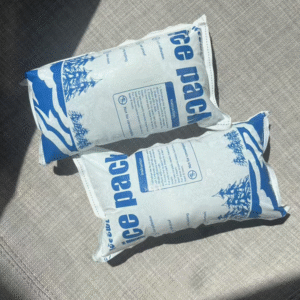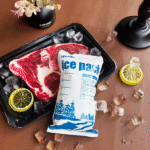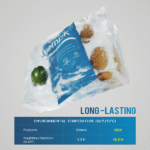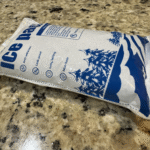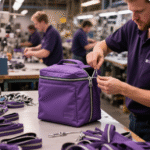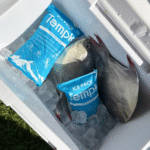Pacotes de gelo seco: Onde comprar 2025 (Guia prático)
Se você está perguntando dry ice packs where to buy em 2025, the best answer depends on whether you need real dry ice (CO₂ sólido) or reusable PCM/gel packs. This guide compares local pickup, online choices, and bulk suppliers, then shows how to size coolant, marca UN1845, and avoid costly mistakes while protecting product temperature. You’ll get fast decision tools and compliant pack-out steps you can use today.
-
Find sources fast: local, on-line, e pacotes de gelo seco a granel with pros and cons.
-
Escolha o refrigerante certo: real dry ice vs PCM “dry‑ice‑level” packs para envio congelado.
-
Ship by the book: 2025 UN1845 rótulos, Aula 9 para o ar, and USPS/FAA limits.
-
Right‑size costs: simples 5–10 lb/24 h regra, plus insulation upgrades that save mass.
-
Act with confidence: a 60‑second chooser and a step‑by‑step pack-out workflow.
Where to buy dry ice packs near you in 2025?
Resposta curta:
Buy real dry ice from industrial gas distributors and grocery chains that stock it; buy “dry‑ice‑level” packs (PCMs) from packaging vendors when hazmat steps aren’t practical. Fornecedores de gás industrial offer pellets/blocks and consistent quality; grocery kiosks are ideal for small, necessidades no mesmo dia; packaging suppliers bundle insulated shippers with gel/PCM packs for non‑hazmat routes.
O que isso significa para você:
Escolha local pickup for urgency and freshness, or schedule distributor delivery for recurring volumes. Usar packaging vendors when you need shippers, rótulos, and coolant in one order. For reusable options, considerar −21 ° C PCM for many frozen lanes and 0 Venha ° c para 2–8 ° C..
Local vs.. entrega: when does each win?
| Tipo de fonte | Opções típicas | Tempo de espera | O que isso significa para você |
|---|---|---|---|
| Industrial gas distributor | Pellets, pepitas, blocos | Same day–48 h | Consistent quality; trained staff; best for volume. |
| Varejo de alimentos | Blocos pré-cortados (varia) | Same day if in stock | Fastest for small runs; ligue antes. |
| Packaging supplier | Remetentes isolados, gel/pcm | 1–3 dias+ | Non‑hazmat routes or mixed coolant kits. |
Practical buying tips
-
Reserve before heat waves/holidays. CO₂ supply can tighten; add time buffers.
-
Confirm what you’re buying. Many “dry ice packs” online are PCM ou gel, CO₂ não sólido; check rated temperature (por exemplo, −21 °C vs −78.5 °C).
-
Bundle supplies. Ordem UN1845/“Dry Ice” Marcas, Aula 9 rótulos (para o ar), forros, and shippers together to avoid last‑minute scrambles.
Caso real: A bakery used grocery kiosks for weekend runs and a distributor mid‑week for pellets. Com um 20% buffer de verão and one standard foam shipper, spoilage claims dropped near zero.
Dry ice packs where to buy online vs. in‑store—what’s smarter?
Resumindo:
Na loja pickup wins for urgent, pequenas quantidades. Online/specialized vendors win for planning, variety, and bundled kits. If you see “dry ice packs” online, they’re often reusable PCMs or gel, não CO₂; that’s great for non‑hazmat lanes but won’t reach -78,5 ° C..
Spot real dry ice vs. “dry ice” packs (reutilizáveis)
| Tipo de refrigerante | Typical phase point | Pátria (ar) | Melhor uso | Significado para você |
|---|---|---|---|---|
| Gelo seco real (Co₂) | ~ −78,5 ° C. | Sim | Frozen profundo, pistas longas | Highest cold power; rótulo & limit apply. |
| Pacote pcm (“−21 °C”) | ≈−15 to −21 °C | Geralmente Não | Frozen foods without hazmat | Easier ops; validate duration. |
| Pacote de gel (0 ° c) | ≈0°C | Não | 2–8 ° C resfriado | Simples, barato; not for rock‑solid frozen. |
Dry ice packs where to buy for bulk and B2B orders?
Go direct para industrial gas distributors for recurring dry ice orders and spec sheets. Emparelhar com contract packaging suppliers for palletized shippers, forros, e etiquetas. For cross‑border programs, usar regional suppliers to reduce transit time and freight.
Volume & international tips
-
Estimate weekly usage (por exemplo, 50 boxes × 5 libra = 250 lb/week). Order a buffer for summer lanes.
-
Plan storage & manuseio. Gelo seco sublimados; usar ventilado, insulated storage. Train on PPE and safe handling.
-
Check air shipment limits and markings if your bulk order moves by air.
-
Leverage supplier expertise for pack‑out design and validation.
How much should you buy—and how do you pack safely?
Regra rápida: Plano ~ 5-10 lb. (2.3–4,5 kg) de gelo seco por 24 h por um pequeno, expedidor bem isolado. Increase mass for thin foam, pistas quentes, or multi‑stop networks. Lugar product low e gelo seco por cima, preencher vazios, and vent the shipper.
Back‑of‑envelope:
Gelo seco (kg) ≈ (horas de espera / 24) × 2.5–4.5 kg/day → validate with a pilot (weigh pre/post to measure sublimation).
How to pack a compliant dry‑ice shipper (passo a passo)
-
Pré -Chill product and shipper.
-
Adicionar forro + absorvente; garantir ventilação for CO₂ gas.
-
Load product low, coloque gelo seco acima isto.
-
Preencher vazios to reduce warm air gaps.
-
Mark the box: “Dry Ice”/“Dióxido de Carbono, sólido", UN1845, Peso líquido (kg); adicionar Aula 9 para o ar.
-
Escolher service level: chão (simpler) vs air (pátria).
60‑second coolant selector (autoverificação)
-
Target temp at delivery?
-
Rock‑solid frozen → Gelo seco
-
Frozen but tolerant of edges → −21 ° C PCM
-
Chilled 2–8 °C → 0 Venha ° c
-
-
Lane time & isolamento?
-
≤24h + thick foam → 5–10 lb. dry ice or adequate PCM
-
48+ h or thin foam → increase mass or upgrade shipper
-
-
Operadora & segment?
-
Ar + limited hazmat capability → PCM
-
1–2 day ground → Dry ice or PCM, based on product tolerance
-
Resultado de campo: A seafood DTC brand swapped dry ice for −15 °C PCM on 1‑day lanes, removing hazmat steps and reducing failed deliveries while holding <−10 °C to POD.
Dry ice packs where to buy if you’re flying or mailing?
-
Passenger air travel: 2.5 kg (5.5 Libra) limit per passenger/package with airline approval; the package must vent and be marked “Dry Ice/Carbon Dioxide, solid” with quantity.
-
Carga aérea: Seguir IATA DGR PI954; marca UN1845, Nome de envio adequado, NET KG, e aplique um Aula 9 label on the same surface when space allows; carriers publish 2025 Listas de verificação.
-
USPS (ar doméstico): Allowed with vented packaging and markings; até 5 lb por correspondência; international USPS is highly restricted.
These specifics reflect 2025 guidance summarized in our internal research.
2025 desenvolvimentos & trends in dry ice and “dry ice pack” buying
O que há de novo (Agosto 2025):
Operadoras atualizadas dry‑ice labeling checklists, reinforcing UN1845/kg marking and overpack notes under the 66th IATA DGR. Fornecimento de co₂ can tighten regionally, so reservations and dual‑sourcing matter. Adoção de PCM keeps rising as shippers seek simpler, reusable coolant for short/medium lanes.
Último progresso em um olhar
-
Rules clarity: Updated checklists reduce labeling errors and holds.
-
Reusable shift: −21 °C PCM bricks replace some dry‑ice lanes without hazmat steps.
-
Supplier networks: More branch locators and regional plants speed local pickup.
Insight de mercado: Cold‑chain growth across food and life sciences expands supply, technology options, and negotiated pricing opportunities. Validate new solutions on your lanes before scaling.
Perguntas frequentes
Q1: Where can I buy small quantities—dry ice packs where to buy today?
Usar grocery kiosks for real dry ice or call nearby industrial gas branches for pellets/blocks; for reusables, grab Pacotes de PCM/gel from packaging catalogs or local retail.
Q2: How much dry ice do I need for a day?
Plano ~5–10 libras por 24 horas por um pequeno, expedidor bem isolado; test and adjust for season and foam thickness.
Q3: Are “dry ice packs” online real dry ice?
Often no—most are PCM ou gel. Check the phase point (por exemplo, −21 °C or 0 °C) and duration in seu tamanho do remetente.
Q4: Preciso de etiquetas especiais para enviar com gelo seco?
Sim: UN1845, Nome adequado, NET KG, e a Aula 9 label for air shipments; o pacote deve ventilação Co₂.
Q5: Is dry ice safe for food and pharma?
Yes—when vented and handled with EPI; evite espaços confinados. Follow exposure guidance and never seal in airtight containers.
Resumo & Recomendações
Pontos -chave: Buy real dry ice from industrial gas ou retail kiosks, and buy PCM/gel when hazmat steps are impractical. Usar ~5–10 lb/24 h como linha de base, colocar ice on top, preencher vazios, e Mark UN1845 com kg. Validate with a lane pilot before scaling.
PRÓXIMOS PASSOS:
-
Decidir temperatura alvo e tempo de trânsito.
-
Escolher gelo seco / −21 ° C PCM / 0 Venha ° c.
-
Reserve local pickup or place a bulk order.
-
Print labels and follow the empacotar steps above.
CTA: Need a lane‑fit coolant plan? Request a 15‑minute sizing review—we’ll deliver a one‑page SOP for your next shipment.
Sobre Tempk
We design validated pack‑outs for gelo seco, PCM, and hybrid solutions and source compliant materials with ready‑to‑print labeling. Across bakeries, kits de refeições, and diagnostics, our programs often reduce coolant mass 15–30% after lane testing—without sacrificing hold time. Talk to us about a route‑specific buy list and SOP you can deploy this week.






